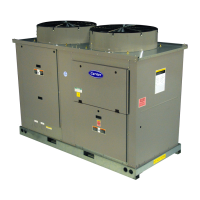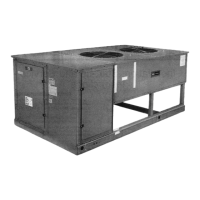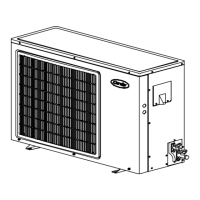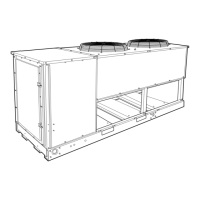174
A152 — Unit Down Due to Failure
Criteria for Trip: This alarm is generated if both circuits are off
due to alerts and/or alarms.
Action To Be Taken: The unit is not allowed to start.
Reset Method: Automatic, once the other alerts/alarms are cor-
rected
Possible Causes: If this condition is encountered, see the
appropriate alert/alarm information in Table 79 on page 163.
T153 — Real Time Clock Hardware Failure Alert
Criteria for Trip: This alert is indicated when the Main Base
Board (MBB) time clock is not initialized or fails to increment.
Action To Be Ta ken: Occupancy defaults to Occupied. Unit
defaults to Local On mode, ignoring any schedules.
Reset Method: Automatic, when the time is initialized or starts
incrementing again.
Possible Causes: If this condition is encountered, check the
following items:
• Check the Hour and Minute (Time Clock
TIME
HH.MM), and reset the time. If the error
returns, replace the board.
• If the unit is connected to a CCN network, and time
broadcast is enabled, repeated broadcasts of time behind
that of the controller will cause this alarm to be gener-
ated. Disconnect the unit from the network to trouble-
shoot the time clock. Check the network settings and
clock.
A154 — Serial EEPROM Hardware Failure
Criteria for Trip: This alarm is indicated when a problem with
the Serial EEPROM (Electrically Erasable Programmable
Read-Only Memory) on the Main Base Board (MBB) has
been detected.
Action To Be Taken: The unit is shut down or not allowed to
start.
Reset Method: Manual.
Possible Causes: If this condition is encountered, reset the
power to the unit. If the error returns, replace the board.
T155 — Serial EEPROM Storage Failure
Criteria for Trip: Configuration data in the serial EEPROM
cannot be verified which may mean Main Base Board replace-
ment. It is possible a re-initialization of the database or particu-
lar storage area(s) by cycling power may correct this problem.
Action To Be Taken: None.
Reset Method: Manual.
Possible Causes: If this condition is encountered, reset the
power to the unit. If the error returns, replace the board.
A156 — Critical Serial EEPROM Storage Failure
Criteria for Trip: Critical configuration data in the serial
EEPROM chip cannot be verified which may mean MBB
replacement. Recovery is automatic but typically board
replacement is necessary.
Action To Be Taken: Unit shuts down or is not allowed to start.
Reset Method: Manual.
Possible Causes: If this condition is encountered, reset the
power to the unit. If the error returns, replace the board.
A157 — A/D Hardware Failure
Criteria for Trip: A problem with the analog to digital conver-
sion chip on the Main Base Board has caused the chip to fail.
Action To Be Taken: Unit shuts down or is not allowed to start.
Reset Method: Manual
Possible Causes: If this condition is encountered, reset the
power to the unit. If the error returns, replace the board.
T170 — Loss of Communication with the Compressor
Expansion Module
Criteria for Trip: This alert is generated when the Main Base
Board (MBB) cannot establish communication with the Com-
pressor Expansion Module (CXB). This board is found on the
38APD070-130 units only.
Action To Be Taken: All CXB functions are disabled.
Reset Method: Automatic once communication is re-estab-
lished.
Possible Causes: If this condition is encountered, check the
following items:
• Confirm unit configuration, Configuration
UNIT
SIZE.
• Check LEN communication wiring.
• Check CXB DIP Switch settings.
• Check for control power to the CXB.
T173 — Loss of Communication with the Energy Manage-
ment Module
Criteria for Trip: This alert is generated when the Main Base
Board (MBB) cannot establish communication with the
Energy Management Module (EMM).
Action To Be Taken: All EMM functions, Switch Controlled
Demand Limit, Y3/Y4 Thermostat Input, 4-20 mA Demand
Limit, 4-20 mA Temperature Reset, 4-20 mA Percent Capac-
ity, and 4-20 mA Cooling Set Point, are disabled.
Reset Method: Automatic once communication is re-estab-
lished.
Possible Causes: If this condition is encountered, check the
following items:
• Confirm unit configuration, EMM Module Installed
(Configuration
OPT1
EMM). If a feature requiring
the EMM is enabled, the control will automatically start
searching for the board. If it is not installed, disable the
feature requiring the EMM.
• Check LEN communication wiring.
• Check EMM DIP switch settings.
• Check for control power to the EMM.
T174 — 4 to 20 mA Cooling Set Point Input Failure
Criteria for Trip: The following conditions must be true:
1. The unit must be configured for either Control Type Con-
figuration
OPT2
C.TYP=7 [PCT CAP] or 9 [VAV
SETPOINT].
2. The Energy Management Module is required and must be
configured, EMM Module Installed, Configuration
OPT1
EMM=YES.
3. The signal is less than 2 mA or greater than 22 mA.
Action To Be Taken: For Configuration
OPT2
C.TYP=7
(PCT CAP) without return air and supply air thermistors, the
function is disabled and the unit is not allowed to start or run.
For Configuration
OPT2
C.TYP=9 (VAV SETPOINT),
the function is disabled. For C.TYP=7 with return air and sup-
ply air thermistors and C.TYP=9, the unit controls will use
Cooling Set Point 1 (Setpoints
COOL
CSP.1) as the Active
Set Point (Run Status
VIEW
SETP).
Reset Method: Automatic once signal is restored.
Possible Causes: If this condition is encountered, check the
following items:
• Confirm the input signal the control is reading. Check
the value of 4-20 Cooling Demand (Inputs Mode
4-
20
CL.MA). Compare this to expected signal strength.
• Confirm that the signal wiring polarity, LVT-8 (–) and
LVT-10 (+), is correct.
• Confirm Energy Management Module configuration,
EMM Module Installed, Configuration
OPT1
EMM=YES.

